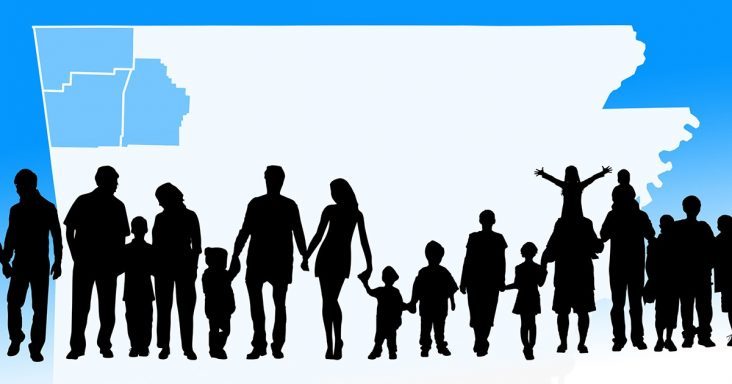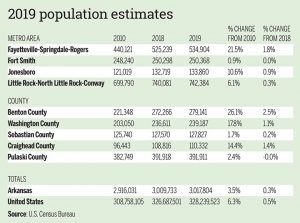Northwest Arkansas continues to lead state growth, 13th fastest-growing U.S. metro over past decade
by March 26, 2020 7:45 am 9,887 views

Northwest Arkansas was the 13th fastest-growing metro area in the United States between 2010 and 2019 and the 24th fastest growing metro from 2018 to 2019, according to the U.S. Census Bureau.
Among U.S. counties with at least 20,000 people, Benton County was the 40th fastest growing county between 2010 and 2019 and the 73rd fastest-growing county from 2018 to 2019.
The Census Bureau released Thursday (March 26) updated population estimates as of July 1, 2019, for 3,142 counties and 384 metropolitan statistical areas in the United States. This will be the last set of estimates the agency releases for the counties and metro areas before the 2020 Census, from which data is expected to be released starting later this year and into 2021.
Between 2010 and 2019, the population of Northwest Arkansas, or the Fayetteville-Springdale-Rogers metro area, increased 21.5%, or by 94,783, to 534,904. The metro is the 107th largest in the United States and had the 44th highest numerical population increase between 2010 and 2019.
From 2018 to 2019, the population rose 1.8%, adding 9,665, or about 26 people per day. It had the 43rd highest numerical population increase from 2018 to 2019. The metro area includes Benton, Madison and Washington counties, and formerly included McDonald County, Mo., but has since been removed, and starting with the new estimates, is no longer included in the population of the metro area.
“Northwest Arkansas is just booming in population and economic growth,” said Michael Pakko, chief economist and state economic forecaster for the Arkansas Economic Development Institute (AEDI) at the University of Arkansas at Little Rock. “That’s part of the makeup of the state’s economy. That’s where we are seeing a large share of the growth in the economy and the population.”
Between 2010 and 2019, the population of Benton County increased 26.1%, or by 57,573, to 279,141. Over that period, Benton County had the 91st highest numerical increase in population among U.S. counties. From 2018 to 2019, the county population rose 2.5%, adding 6,875, or nearly 19 people per day. Over that period, Benton County had the 62nd highest numerical increase in population among U.S. counties.
Between 2010 and 2018, only 26 of the 75 counties in the state had positive growth rates, Pakko noted. Only 28 counties in 2018 had positive growth, and he expected 2019 data to follow that trend.
“One interesting trend we have seen this decade is widespread population decline among smaller counties, while larger counties tended to have population growth,” said Christine Hartley, a demographer with the Population Division of the Census Bureau. “Three out of four counties with a population of less than 10,000 in 2010 had even smaller populations in 2019. At the same time, three out of four counties of 50,000 or more were larger in 2019 compared to 2010.” The pattern among larger counties was more evident in the West and South.
The Villages, Fla., metro area was the fastest-growing U.S. metro between 2010 and 2019 as the area’s population rose 41.7% to 132,420. The St. George, Utah, metro area was the fastest-growing metro from 2018 to 2019, with its population rising 3.5% to 177,556. Between 2010 and 2019, the Dallas-Fort Worth-Arlington, Texas, metro area had the largest numeric population growth, increasing 19%, or by 1.2 million. Of counties with a population of at least 20,000, Williams County, N.D., was the fastest-growing county, increasing 67.8%, or by 15,190, between 2010 and 2019.
OTHER ARKANSAS METROS
The population of the Little Rock-North Little Rock-Conway metro area increased 6.1%, from 699,790 in 2010 to 742,384 in 2019. From 2018 to 2019, the population rose 0.3%, adding 2,303 people. The metro area is the 78th largest in the United States and includes the following counties: Pulaski, Faulkner, Grant, Lonoke, Perry and Saline.
The population of the Fort Smith metro rose 0.9%, from 248,240 in 2010 to 250,368 in 2019. From 2018 to 2019, the population increased by 70. Like the Northwest Arkansas metro, a county was removed from population estimates attributed to the Fort Smith metro. With the new estimates, Le Flore County, Okla., is no longer included in the population for the metro area, but Franklin County was added and is part of the population of the area, which includes Sebastian, Crawford, Franklin counties in Arkansas and Sequoyah County, Okla.

Pakko explained the connection between population growth and economic growth holds for both Northwest Arkansas and Northeast Arkansas, which includes the Jonesboro metro area.
“What we’re seeing is population growth and economic growth going hand in hand,” he said. “Those are two parts of the state that are showing the highest growth rates in employment, so there’s kind of a feedback relationship there. People are migrating to where the jobs are. That creates more economic activity and more jobs. There’s really these pockets of growth in the state.
“Central Arkansas is also growing but at a much more modest pace,” he added. “Then, you’ll find all around the rest of the state much slower growth rate of both population and economic growth.”
Pakko said a long-term trend has been for population growth in metro areas, especially as the economy shifts to a service economy. Most metro areas are doing better than rural parts of the state. In the Little Rock metro, there’s not a lot of new developments and growth, but the state capital has a diverse economy and continues to grow as the largest metro area in the state, he said. And it’s benefitting from the central position within the economy.
Regarding the Fort Smith metro, he said the population trends have reflected the economic trends there. The growth rate in Fort Smith has been low as a result of setbacks with the loss of manufacturing jobs dating back to the Great Recession, Pakko said, adding that he wasn’t surprised to see the low population growth.
COMPONENTS OF CHANGE
AEDI demographer Diego Caraballo said he was surprised at the level of international migration coming to the Northwest Arkansas metro, at nearly 11,000 over the past decade while the Little Rock metro had almost 8,000. Northwest Arkansas also had the highest net migration in the state from 2018 to 2019, at more than 6,000 in total net migration, compared to about 150 in the Little Rock metro and almost 750 in the Jonesboro metro.
The Fort Smith metro lost population as a result of migration, Caraballo said, noting that more people are moving from the area than moving in. It had a negative net migration of nearly 500 from 2018 to 2019. With regard to the Jonesboro metro, domestic migration accounted for most of the net migration there.
Between 2018 and 2019, Northwest Arkansas had the second-highest birth rate of any Arkansas metro, and it also has very few deaths compared to other metro areas in the state. Northwest Arkansas had more than 7,000 births but half that amount of deaths, while the Little Rock metro had 9,000 births and nearly 7,000 deaths. The Fort Smith metro had more than 3,200 births and over 2,600 deaths. The Jonesboro metro had nearly 1,800 births and almost 1,400 deaths.
STATEWIDE COUNTY GROWTH
Though Benton County is the fastest-growing county in the state, the population of Washington County, also in Northwest Arkansas, rose 17.8%, from 203,050 in 2010 to 239,187 in 2019. From 2018 to 2019, the population increased by 1.1%, adding 2,576.
In central Arkansas, the population of Pulaski County rose 2.4%, from 382,749 in 2010 to 391,911 in 2019. From 2018 to 2019, the population declined by seven. Pakko noted a trend in mature metro areas is the population growth that shifts to outlying counties, such as Faulkner, Saline and Lonoke counties.
“You’ll see the largest percentage increases of population there, and that contributes to the overall population of the metropolitan area but less growth within the central county,” he said.
In western Arkansas, the population of Sebastian County rose 1.7%, from 125,740 in 2010 to 127,827 in 2019. From 2018 to 2019, the population increased by 0.2%, adding 257.
In northeast Arkansas, the population of Craighead County increased 14.4%, from 96,443 in 2010 to 110,332 in 2019. From 2018 to 2019, the population rose 1.4%, adding 1,516.
